
views
- Spray a solution of half water and half white vinegar onto the cast iron grates and let it sit for 30 minutes. Then, wipe the grates with a damp sponge or cloth.
- Apply a baking soda paste to the grates and let it sit for 15–30 minutes. Scrub the grates with a damp sponge, and rinse the baking soda off.
- Spray a degreaser or oven cleaner onto your grates and let them sit for the time listed on the label. Wipe the cleaner off with a damp cloth.
Soapy Water
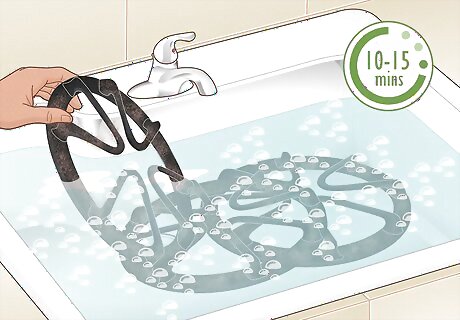
Soak porcelain-coated grates in hot soapy water for 10–15 minutes. Turn your faucet to the hottest setting and fill your sink with enough water to submerge the cast iron grates. Then, add in a few drops of dish soap and mix it into the water. Wait until the grates are completely cool before submerging them for 10–15 minutes. If there are thick layers of grease on your grates, slowly pour boiling water over them first to help melt the residue away. It’s perfectly safe to clean cast iron with soap. A little bit of soap won’t remove the protective coating over your cast iron. If your grates are made of uncoated cast iron, they’ll have a dull appearance. Avoid soaking them since they could form rust.
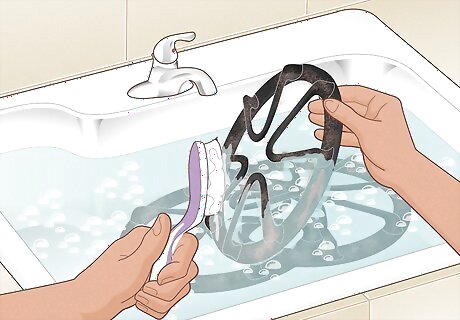
Scrub the grates with a soft-bristle brush. Whether you’re cleaning coated or uncoated cast iron grates, wet the bristles of a toothbrush or a cleaning brush in soapy water. Then, gently scrub the grates to break apart any food or grease that’s still on the surface. Avoid using steel wool or abrasive sponges since they could scratch or damage your grates, which could lead to rust. Cast iron stove grates are not dishwasher-safe since the water and heat could cause them to develop rust. Stick to washing the grates by hand.
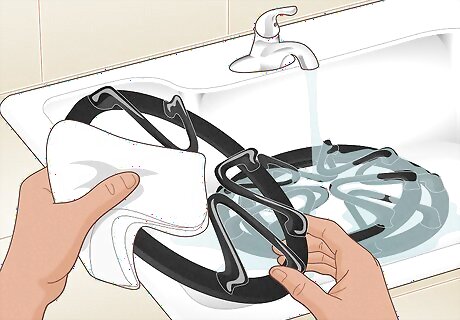
Rinse the grates with warm water and dry them with a towel. Run warm water over the grates to rinse all the suds off the surface. Use a paper towel or soft microfiber cloth to gently wipe the grates dry so they don’t form rust. Then, just set the grates back onto your stove. Don’t forget to clean your stovetop before putting the grates back on. If your cast iron grates have stubborn residue, then try washing them again. If the grease or food is still there, then try one of the other cleaning methods.
Vinegar Solution
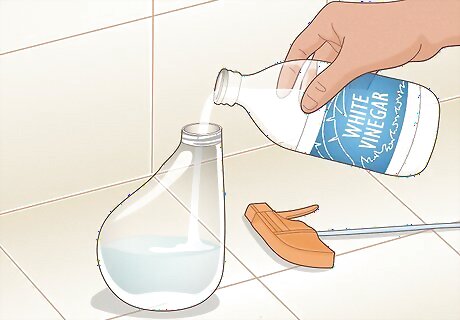
Pour a solution of equal parts water and vinegar into a spray bottle. Fill half of a spray bottle with warm water and pour in distilled white vinegar until it’s full. Vinegar works best for getting rid of light grease stains and weekly cleanings. Acid in the vinegar helps break apart the residue on the grates, and it’s a perfect homemade cleaner if you want to avoid chemical products.
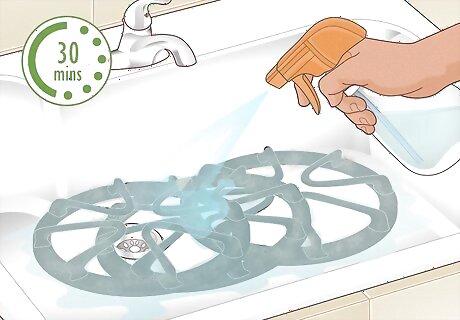
Coat the grates with the vinegar solution and let them sit for 30 minutes. Set your cast iron grates in your sink and liberally spray them with the vinegar solution. Make sure you get into all the hard-to-reach corners. Then, leave the vinegar to work its magic for at least 30 minutes. Alternatively, fill a large container with half water and half vinegar and submerge the grates completely.
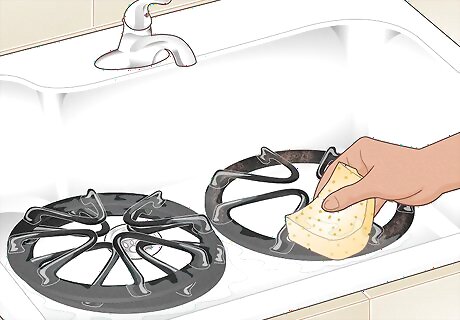
Scrub the grates with a sponge and rinse them off. Wet a non-abrasive sponge and wipe the vinegar solution off your stove grates. Keep running the sponge over areas with built-up grease or food residue to loosen them up, and apply more vinegar solution to help break it down even more. Once your stove grates are completely clean, rinse them off with warm water and pat them dry with a towel. Use a toothbrush to scrub away any hard-to-reach nooks and crevices.
Baking Soda Paste

Rinse the grates with hot water. Put your cast iron grates in the sink and run the hottest water from the tap over them. The heat will help remove any layers of grease or loose food on the surface so the baking soda works better on the stuck-on material underneath. Baking soda also helps remove rust from your cast iron since it’s slightly abrasive.
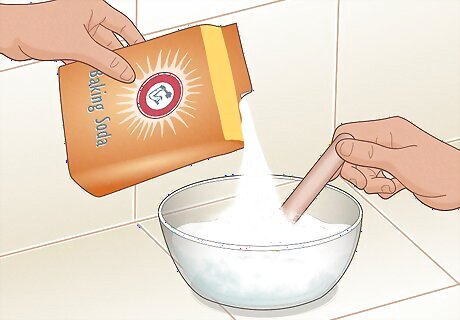
Combine baking soda and water into a thick paste. Stir 3 parts baking soda and 1 part water in a small bowl until it has a thick consistency that will stick to the grates. Alternatively, use distilled white vinegar instead of water to help clean stubborn rust or food residue.
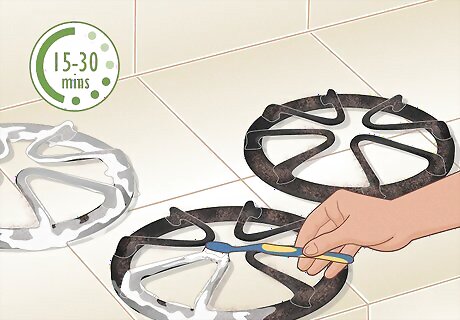
Spread the paste on the grates and let it sit for 15–30 minutes. Use a toothbrush or damp rag to apply the paste to your stove grates. Work the paste into all the nooks and crannies before setting the grates on a towel for about 15–30 minutes. As the baking soda sits on the metal, it will eat away at any excess food or grease buildup.

Scrub off the buildup with a non-abrasive sponge and rinse thoroughly. Wet your sponge and run it over your stove grates to wipe away the baking soda. Work the paste into any areas where you still see stubborn food and grease stains. When you’re finished, run clean water over your cast iron grates and pat them with a towel to dry.
Degreaser or Oven Cleaner
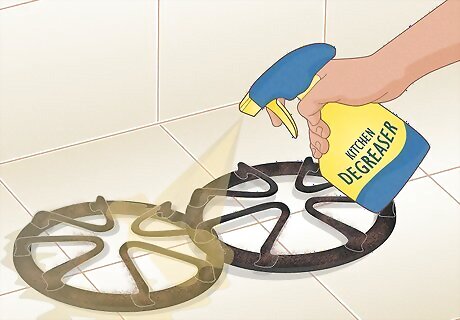
Spread a commercial degreaser or oven cleaner over the grates. Spray the degreaser or oven cleaner onto the grates until they’re completely coated. If you can’t reach all the nooks and crannies on your stove grates, use a toothbrush to spread the cleaner over the area. Work in a well-ventilated space since degreasers and oven cleaners contain chemicals that may cause irritation if you breathe them in. Degreasers and oven cleaners work well if your cast iron stove grates are turning white since they’ll effectively remove the residue and discoloration.

Let the degreaser sit for the recommended time on the package. Degreasers all work a little differently, so check the package to see how long it needs to work. Most degreasers take about 25–30 minutes, but oven cleaners may take 40–50 minutes to break down tough residue and grease stains. Check the grates every 15 minutes or so to make sure they’re still wet with the cleaner, and reapply more if they’re starting to dry out.
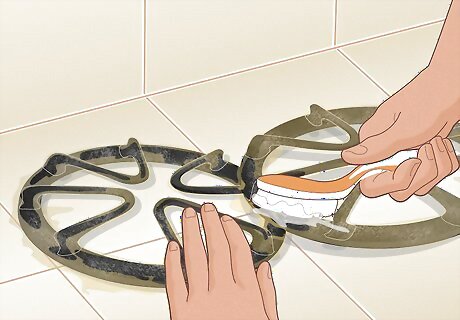
Scrub the grates with a soft-bristle brush or sponge. Wet your brush or sponge with warm water and gently scrub the cast iron surface. All of the stuck-on residue and grease stains will easily lift up, leaving behind a clean surface. It may require some additional elbow grease, but it won’t leave your grates with a bunch of ugly scratches. Avoid using steel wool or a stiff-bristled brush since you could scratch or damage the grates.
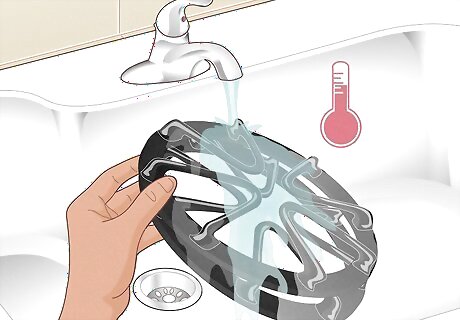
Rinse your stove grates with warm water and dry them with a towel. Run the grates underneath warm running water to get rid of any residual cleaner or food still on the surface. After that, pat the grates dry with a paper towel or soft microfiber cloth, and put them back on your stovetop.
Ammonia

Put your stove grates into plastic bags. Stovetop grates come in a variety of sizes, but most individual burner grates will fit into gallon-sized bags. If you have longer grates that span your entire stovetop or want to clean multiple small grates at once, then use a large garbage bag instead. If you don’t have any bags, use a large container with a lid so it traps the ammonia fumes inside.
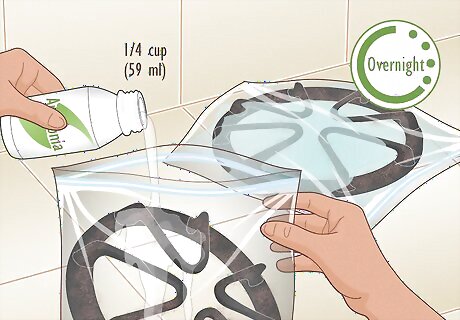
Add ⁄4 c (59 ml) of ammonia to the bags and seal them overnight. Pour the ammonia directly into the bag and close it immediately to trap in the fumes. It’s okay if the ammonia doesn’t completely cover or submerge the grates since the fumes cause the grime and grit to loosen up. Leave the grates in the bag overnight to help remove the most residue. Ammonia fumes may irritate your nose, throat, and lungs if you breathe them in, so always keep a window open or a fan running to ventilate the area.
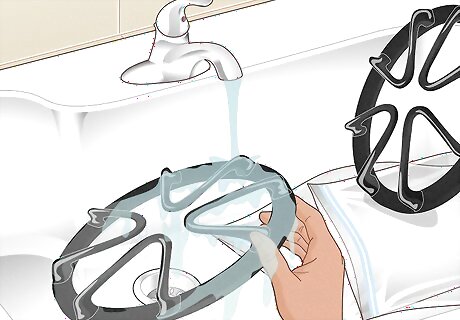
Remove and rinse your grates under warm running water. The following day, open the bags and take the grates out. Rinse them underneath warm water from your sink to get any residual ammonia and food particles off the surface.If there’s any residue that’s still a little stuck, use a sponge to clean off any excess gunk. Then, just dry the grates off with a clean towel. Reseal the bags and toss them in your trash to prevent the ammonia from spilling out.










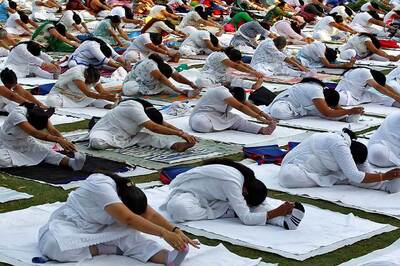





Comments
0 comment